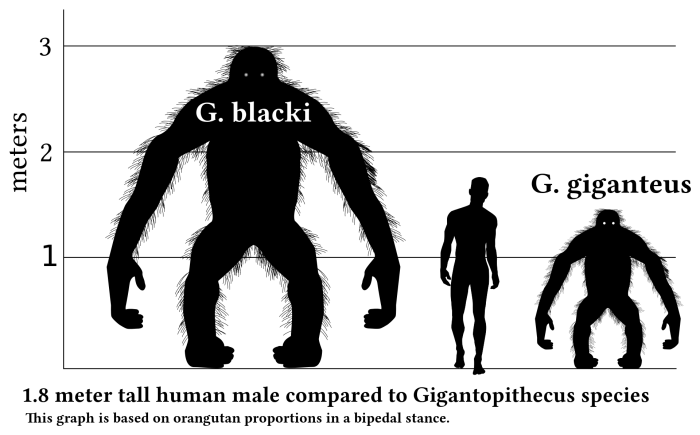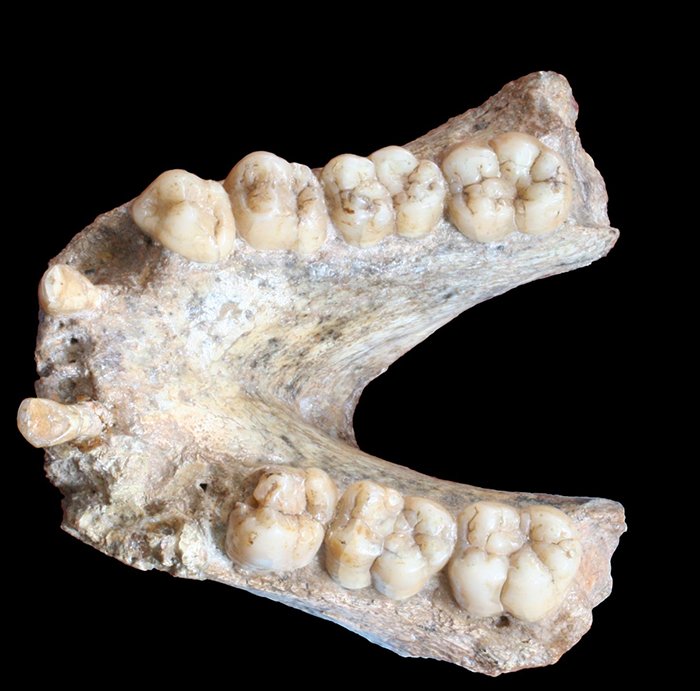Along with Godzilla, King Kong is one of the greatest movie monsters of all time. And as it turns out, he was also kind of, sort of, maybe, just a little bit real! It was a prehistoric ape called Gigantopithecus blacki.
Though it went extinct around 300,000 years ago, this was a truly stunning animal. It stood about 3 metres (9.6 feet) tall, and weighed around 600 kilograms (1,300 lbs.). Okay, that's still quite a bit smaller than the massive movie version King Kong, but it's still big! And now, new evidence shows that there's another big difference between the world of movies and reality.
Relatively speaking

This chart shows the size difference between an adult male G. blacki, an average adult male human, and an adult male orangutan (G. giganteus). (Discott/Wikimedia Commons)
In films, King Kong has always looked like an overgrown mountain gorilla. This makes sense, as these are the most physically powerful (and powerful-looking) of the modern great apes. But according to a new study, they are not the closest living relatives of Gigantopithecus blacki.
That title actually goes to the orangutan.
The tooth of truth

Researchers used these teeth to decode the family tree of these ancient apes. (Prof. Wei Wang/Theis Jensen)
Scientists made this connection thanks to recent evidence that looked at 2 million-year-old teeth of a Gigantopithecus blacki. Thankfully, the enamel of teeth protect the proteins inside, meaning that scientists can peer deep into the past.
By comparing the protein sequences with those of other hominids both alive and dead (including modern great apes and humans), the researchers at the University of Copenhagen in Denmark estimate that the species of orangutans and G. blacki split off from each other around 10 to 12 million years ago.
But while the dental data can confirm that these giants apes are most closely related to everyone's favourite orange-furred primate, it doesn't tell us anything about what they looked like. Were they basically just overgrown orangutans? Or did they have an appearance that was more like the fearsome primate kings of Hollywood?
Our bet is on the first one. After all, for all of their size, analysis suggests that they mostly ate fruits, seeds, and bamboo. Though they were giants, they were likely ones looking to be left alone to live a peaceful life in ancient South Asian forests. Not unlike orangutans, actually!
 Is this the descendant of the biggest ape to ever live? A new study says it's probably true. (© Elena Schweitzer - Dreamstime.com)
Is this the descendant of the biggest ape to ever live? A new study says it's probably true. (© Elena Schweitzer - Dreamstime.com)










It sounds like that giant ape resembles the ape mighty joe young witch supposedly a fictional character.
Orangs were not likely descendants of Gigantopithecus but close “cousins” of them.
I doubt that Gigantopithecus blacki was as tall and as heavy as claimed. Simply scaling up from gorillas by tooth and jaw sizes is unreliable.
I wish articles like this would quit stating as though it’s a fact that Gigantopithecus was proven to be about 10 ft tall. The first scientists who estimated its size, Pei and Koenigswald, used an unreliable method, merely using the jaw size to scale up from gorillas. But possibly it had a jaw or even a whole head disproportionately large for its total body size. Its smallest jaw size overlaps those of the largest mountain gorillas, so it may have not been much larger than them. About 7 ft and 600 to 700 lbs seems a reasonable maximum.